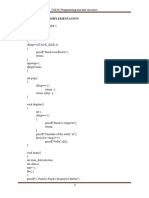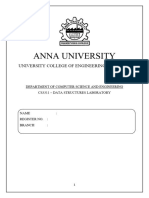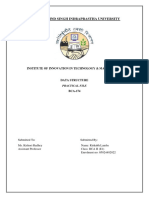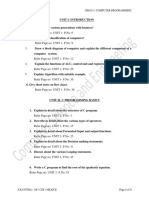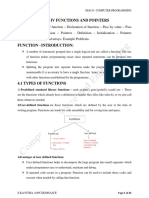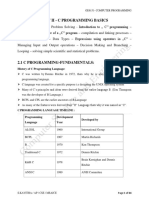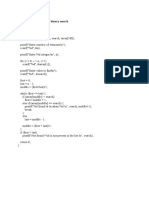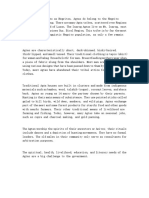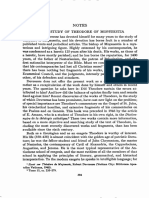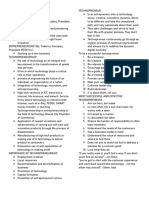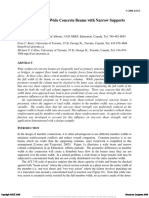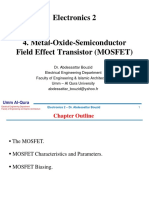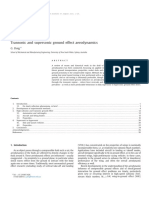CS6202- Programming & Data structures
LIST-ARRAY IMPLEMENTATION
#include<stdio.h>
#define MAX 10
int a[10];
int i,ch,n;
void insert()
{
int i,num,pos;
printf("enter the number to insert\n");
scanf("%d", &num);
printf("enter the position in which it has to be inserted\n");
scanf("%d", &pos);
for(i=n;i>=pos;i--)
{
a[i]=a[i-1];
}
a[pos]=num;
n++;
}
void insfirst()
{
int i,num;
printf("enter the number to insert\n");
scanf("%d", &num);
for(i=n;i>=0;i--)
{
a[i]=a[i-1];
}
a[0]=num;
n++;
}
void inslast()
{
int num;
printf("enter the number to insert\n");
scanf("%d",&num);
a[n]=num;
n++;
}
void display()
{
1
� CS6202- Programming & Data structures
int i;
printf("list elemts\n");
for(i=0;i<n;i++)
{
printf("%d\t",a[i]);
}
}
void search()
{
int i,num;
printf("enter the element to be searched\n");
scanf("%d",&num);
for(i=0;i<n;i++)
{
if(a[i]==num)
{
printf("\n The element %d is present at the %dth position",num,i+1);
return;
}
}
}
void del()
{
int pos,i;
printf("enter the position of elmt to be deleted\n");
scanf("%d",&pos);
for(i=pos;i<n;i++)
{
a[i-1]=a[i];
}
n--;
}
void main()
{
printf("------creating a list------\n\n" );
printf("Enter the number of elements in the list\n");
scanf("%d",&n);
if(n>MAX)
{
printf("out of range\n");
}
2
� CS6202- Programming & Data structures
printf("enter the elements \n");
for(i=0;i<n;i++)
{
scanf("%d", &a[i]);
}
printf("elements in the list\n");
for(i=0;i<n;i++)
{
printf("%d\t", a[i]);
}
while(1)
{
printf("\n\n1.Insert\n");
printf("2.Display\n");
printf("3.Delete\n");
printf("4.search\n");
printf("5.Insertfirst\n");
printf("6.InsertLast\n");
printf("7.Exit\n");
scanf("%d",&ch);
switch(ch)
{
case 1:
insert();
break;
case 2:
display();
break;
case 3:
del();
break;
case 4:
search();
break;
case 5:
insfirst();
break;
case 6:
inslast();
break;
case 7:
exit(0);
}
}
3
� CS6202- Programming & Data structures
OUTPUT:
------creating a list------
Enter the number of elements in the list
3
enter the elements
1
2
3
elements in the list
1 2 3
1.Insert
2.Display
3.Delete
4.search
5.Insertfirst
6.InsertLast
7.Exit
1
enter the number to insert
4
enter the position in which it has to be inserted
2
1.Insert
2.Display
3.Delete
4.search
5.Insertfirst
6.InsertLast
7.Exit
2
list elemts
1 2 4 3
1.Insert
2.Display
3.Delete
4.search
5.Insertfirst
6.InsertLast
7.Exit
4
4
� CS6202- Programming & Data structures
enter the element to be searched
2
The element 2 is present at the 2th position
1.Insert
2.Display
3.Delete
4.search
5.Insertfirst
6.InsertLast
7.Exit
5
enter the number to insert
8
1.Insert
2.Display
3.Delete
4.search
5.Insertfirst
6.InsertLast
7.Exit
2
list elemts
8 1 2 4 3
1.Insert
2.Display
3.Delete
4.search
5.Insertfirst
6.InsertLast
7.Exit
6
enter the number to insert
5
1.Insert
2.Display
3.Delete
4.search
5.Insertfirst
6.InsertLast
7.Exit
2
list elemts
8 1 2 4 3 5
1.Insert
5
� CS6202- Programming & Data structures
2.Display
3.Delete
4.search
5.Insertfirst
6.InsertLast
7.Exit
3
enter the position of elmt to be deleted
3
1.Insert
2.Display
3.Delete
4.search
5.Insertfirst
6.InsertLast
7.Exit
2
list elemts
8 1 4 3 5
6
� CS6202- Programming & Data structures
SINGLY LINKED LIST – LINKED LIST IMPLEMENTATION
#include <stdio.h>
typedef struct node *list;
typedef struct node *position;
list head;
struct node
{
int element;
struct node *next;
};
int isempty(list l)
{
return l->next==NULL;
}
int islast(position p)
{
return p->next==NULL;
}
list getnode()
{
position p;
p=(list)malloc(sizeof(struct node));
return p;
}
void display(list l)
{
printf("The list elements are:\n");
while(l->next!=NULL)
{
printf("%d->",l->element);
l=l->next;
}
printf("%d->",l->element);
position find(int x,list l)
{
position p;
p=l->next;
7
� CS6202- Programming & Data structures
while(p!=NULL && p->element!=x)
p=p->next;
return p;
}
void insert(int x,position p)
{
position new,tmpcell;
int ch,key;
new=p;
tmpcell=getnode();
if(tmpcell==NULL)
{
printf("out of space\n");
}
printf("\n1.first\n2.middle\n3.last\n");
printf("Enter the choice:\n");
scanf("%d",&ch);
switch(ch)
{
case 1:
tmpcell->element=x;
tmpcell->next=p->next;
p->next=tmpcell;
break;
case 2:
printf("\nEnter the key after which it has to be inserted: ");
scanf("%d",&key);
p=find(key,new);
tmpcell->element=x;
tmpcell->next=p->next;
p->next=tmpcell;
break;
case 3:
while(new->next!=NULL)
{
new=new->next;
}
tmpcell->element=x;
tmpcell->next=NULL;
new->next=tmpcell;
8
� CS6202- Programming & Data structures
break;
}
}
void create ( )
{
head=getnode();
printf("\nEnter the header element:");
scanf("%d",&head->element);
head->next=NULL;
}
position findprevious(int x, list l)
{
position p;
p=l;
while(p->next!=NULL && p->next->element!=x)
p=p->next;
return p;
}
void deletion(list l)
{
int x,ch;
position p,tmpcell;
if(l->next==NULL)
printf("LIST IS EMPTY\n");
else
{
printf("\n1.first\n2.middle\n3.last\n");
printf("Enter the choice:\n");
scanf("%d",&ch);
switch(ch)
{
case 1:
if(l->next->next==NULL)
{
l->next=NULL;
free(l->next);
}
else
{
tmpcell=l->next;
9
� CS6202- Programming & Data structures
l->next=l->next->next;
free(tmpcell);
}
break;
case 2:
printf("\nEnter the elemnt to be deleted:");
scanf("%d",&x);
p=findprevious(x,l);
if(!islast(p))
{
tmpcell=p->next;
p->next=tmpcell->next;
free(tmpcell);
}
break;
case 3:
p=l;
while(p->next!=NULL)
{
tmpcell=p;
p=p->next;
}
tmpcell->next=NULL;
free(p);
break;
}
}
}
void main()
{
list p;
int choice,ele,key;
while(1)
{
printf("\n1.Create\n2.Display\n3.Insert\n4.Delete\n5.Exit");
printf("\nEnter the choice:");
scanf("%d",&choice);
switch(choice)
{
case 1:
create();
10
� CS6202- Programming & Data structures
break;
case 2:
display(head);
break;
case 3:
printf("\nEnter the element:");
scanf("%d",&ele);
insert(ele,head);
break;
case 4:
deletion(head);
break;
case 5:
exit(0);
}
}
}
OUTPUT:
1.Create
2.Display
3.Insert
4.Delete
5.Exit
Enter the choice:1
Enter the header element:0
1.Create
2.Display
3.Insert
4.Delete
5.Exit
Enter the choice:3
Enter the element:2
1.first
2.middle
3.last
Enter the choice:
1
1.Create
2.Display
11
� CS6202- Programming & Data structures
3.Insert
4.Delete
5.Exit
Enter the choice:3
Enter the element:5
1.first
2.middle
3.last
Enter the choice:
3
1.Create
2.Display
3.Insert
4.Delete
5.Exit
Enter the choice:2
The list elements are:
0->2->5->
1.Create
2.Display
3.Insert
4.Delete
5.Exit
Enter the choice:3
Enter the element:4
1.first
2.middle
3.last
Enter the choice:
2
Enter the key after which it has to be inserted: 2
1.Create
2.Display
3.Insert
4.Delete
5.Exit
Enter the choice:3
Enter the element:8
1.first
2.middle
3.last
Enter the choice:
1
1.Create
12
� CS6202- Programming & Data structures
2.Display
3.Insert
4.Delete
5.Exit
Enter the choice:3
Enter the element:9
1.first
2.middle
3.last
Enter the choice:
1
1.Create
2.Display
3.Insert
4.Delete
5.Exit
Enter the choice:2
The list elements are:
0->9->8->2->4->5->
1.Create
2.Display
3.Insert
4.Delete
5.Exit
Enter the choice:4
1.first
2.middle
3.last
Enter the choice:
1
1.Create
2.Display
3.Insert
4.Delete
5.Exit
Enter the choice:2
The list elements are:
0->8->2->4->5->
1.Create
2.Display
3.Insert
4.Delete
5.Exit
13
� CS6202- Programming & Data structures
Enter the choice:4
1.first
2.middle
3.last
Enter the choice:
3
1.Create
2.Display
3.Insert
4.Delete
5.Exit
Enter the choice:2
The list elements are:
0->8->2->4->
1.Create
2.Display
3.Insert
4.Delete
5.Exit
Enter the choice:4
1.first
2.middle
3.last
Enter the choice:
2
Enter the elemnt to be deleted:2
1.Create
2.Display
3.Insert
4.Delete
5.Exit
Enter the choice:2
The list elements are:
0->8->4->
1.Create
2.Display
3.Insert
4.Delete
5.Exit
Enter the choice:
14
� CS6202- Programming & Data structures
DOUBLY LINKED LIST
#include<stdio.h>
typedef struct node *list;
typedef struct node *position;
list head;
position p;
struct node
{
int ele;
position next;
position prev;
};
position create();
position find(int,list);
void insert(int,list);
void display(list);
void deletion(list);
void main()
{
int choice,ele,key;
while(1)
{
printf("\n1.Create\n2.Display\n3.Insert\n4.Delete\n5.Exit");
printf("\nEnter the choice:");
scanf("%d",&choice);
switch(choice)
{
case 1:
head=create();
break;
case 2:
display(head);
break;
case 3:
printf("\nEnter the element:");
scanf("%d",&ele);
insert(ele,head);
break;
15
� CS6202- Programming & Data structures
case 4:
deletion(head);
break;
case 5:
exit(0);
}
}
}
void deletion(list temp)
{
position r;
int ch,x;
r=temp;
printf("\n\n1.Start\n2.Intermediate\n3.End");
printf("\nEnter the choice: ");
scanf("%d",&ch);
switch(ch)
{
case 1:
r=temp->next;
if(temp->next->next==NULL)
{
printf("deleted element is %d and list is now empty\n",r->ele);
temp->next=NULL;
free(r);
}
else
{
printf("deleted element is %d\n",r->ele);
r->next->prev=temp;
temp->next=r->next;
free(r);
}
break;
case 2:
printf("\nEnter the element to be deleted:");
scanf("%d",&x);
p=find(x,temp);
p->prev->next=p->next;
p->next->prev=p->prev;
free(p);
16
� CS6202- Programming & Data structures
break;
case 3:
while(r->next!=NULL)
{
r=r->next;
}
temp=r->prev;
temp->next=NULL;
free(r);
break;
}
}
position create()
{
head=(list)malloc(sizeof(struct node));
if(head==NULL)
{
printf("\nunable 2 create head node");
}
printf("\nEnter the header node value:");
scanf("%d",&head->ele);
head->prev=head->next=NULL;
return head;
}
position find(int x,list temp)
{
while(temp!=NULL&&temp->ele!=x)
{
temp=temp->next;
}
return temp;
}
void insert(int x,list head)
{
int ch,key;
position temp;
position r;
r=head;
if(head==NULL)
{
17
� CS6202- Programming & Data structures
printf("\nList is empty create a header node and try");
}
printf("\n\n1.Beggining\n2.Middle\n3.End");
printf("\nEnter the choice: ");
scanf("%d",&ch);
switch(ch)
{
case 1:
temp=(list)malloc(sizeof(struct node));
temp->ele=x;
temp->prev=head;
temp->next=head->next;
if(temp->next!=NULL)
{
head->next->prev=temp;
}
head->next=temp;
break;
case 2:
printf("\nEnter the elment after which it has to be inserted: ");
scanf("%d",&key);
temp=(list)malloc(sizeof(struct node));
p=find(key,head);
temp->ele=x;
temp->prev=p;
temp->next=p->next;
temp->next->prev=temp;
p->next=temp;
break;
case 3:
temp=(list)malloc(sizeof(struct node));
temp->ele=x;
while(r->next!=NULL)
{
r=r->next;
}
temp->prev=r;
temp->next=NULL;
r->next=temp;
break;
}
}
18
� CS6202- Programming & Data structures
void display(position head)
{
position p;
p=head;
while(p->next!=NULL)
{
printf("%d\t",p->ele);
p=p->next;
}
printf("%d",p->ele);
}
OUTPUT:
1.Create
2.Display
3.Insert
4.Delete
5.Exit
Enter the choice:1
Enter the header node value:0
1.Create
2.Display
3.Insert
4.Delete
5.Exit
Enter the choice:3
Enter the element:1
1.Beggining
2.Middle
3.End
Enter the choice: 1
1.Create
2.Display
3.Insert
4.Delete
5.Exit
Enter the choice:3
Enter the element:4
1.Beggining
2.Middle
3.End
Enter the choice: 3
19
� CS6202- Programming & Data structures
1.Create
2.Display
3.Insert
4.Delete
5.Exit
Enter the choice:2
0 1 4
1.Create
2.Display
3.Insert
4.Delete
5.Exit
Enter the choice:3
Enter the element:6
1.Beggining
2.Middle
3.End
Enter the choice: 2
Enter the elment after which it has to be inserted: 1
1.Create
2.Display
3.Insert
4.Delete
5.Exit
Enter the choice:3
Enter the element:8
1.Beggining
2.Middle
3.End
Enter the choice: 1
1.Create
2.Display
3.Insert
4.Delete
5.Exit
Enter the choice:3
Enter the element:9
1.Beggining
2.Middle
3.End
Enter the choice: 3
1.Create
2.Display
3.Insert
20
� CS6202- Programming & Data structures
4.Delete
5.Exit
Enter the choice:2
0 8 1 6 4 9
1.Create
2.Display
3.Insert
4.Delete
5.Exit
Enter the choice:4
1.Start
2.Intermediate
3.End
Enter the choice: 2
Enter the element to be deleted:1
1.Create
2.Display
3.Insert
4.Delete
5.Exit
Enter the choice:2
0 8 6 4 9
1.Create
2.Display
3.Insert
4.Delete
5.Exit
Enter the choice:4
1.Start
2.Intermediate
3.End
Enter the choice: 1
deleted element is 8
1.Create
2.Display
3.Insert
4.Delete
5.Exit
Enter the choice:4
1.Start
2.Intermediate
3.End
Enter the choice: 3
21
� CS6202- Programming & Data structures
1.Create
2.Display
3.Insert
4.Delete
5.Exit
Enter the choice:2
0 6 4
22
� CS6202- Programming & Data structures
CIRCULAR LINKED LIST:
#include <stdio.h>
typedef struct node *list;
typedef struct node *position;
list head;
struct node
{
int element;
struct node *next;
};
list getnode()
{
position p;
p=(list)malloc(sizeof(struct node));
return p;
}
void display(list l)
{
position temp;
printf("The list elements are:\n");
if(l->next==head)
{
printf("List is empty\n");
return;
}
temp=head->next;
while(temp!=head)
{
printf("%d->",temp->element);
temp=temp->next;
}
}
position find(int x,list l)
{
position p;
p=l->next;
while(p!=head && p->element!=x) //changes
p=p->next;
return p;
}
23
� CS6202- Programming & Data structures
void insert(int x)
{
position cur,tmpcell;
int ch,key;
tmpcell=getnode();
if(tmpcell==NULL)
{
printf("out of space\n");
}
printf("\n1.first\n2.middle\n3.last\n");
printf("Enter the choice:\n");
scanf("%d",&ch);
switch(ch)
{
case 1:
tmpcell->element=x;
tmpcell->next=head->next;
head->next=tmpcell;
break;
case 2:
printf("\nEnter the key after which it has to be inserted: ");
scanf("%d",&key);
cur=find(key,head);
tmpcell->element=x;
tmpcell->next=cur->next;
cur->next=tmpcell;
break;
case 3:
cur=head->next;
while(cur->next!=head) //changes
{
cur=cur->next;
}
tmpcell->element=x;
tmpcell->next=head; //changes
cur->next=tmpcell;
break;
}
}
24
� CS6202- Programming & Data structures
void create ( )
{
head=getnode();
printf("\nEnter the header element:");
scanf("%d",&head->element);
head->next=head; ///changes
}
void deletion(list l)
{
int x,ch;
position p,tmpcell;
if(l->next==NULL)
printf("LIST IS EMPTY\n");
else
{
printf("\n1.first\n2.middle\n3.last\n");
printf("Enter the choice:\n");
scanf("%d",&ch);
switch(ch)
{
case 1:
if(l->next->next==head) //changes
{
l->next=head; //changes
free(l->next);
}
else
{
tmpcell=l->next;
l->next=l->next->next;
free(tmpcell);
}
break;
case 2:
printf("\nEnter the elemnt to be deleted:");
scanf("%d",&x);
position prev;
p=l;
while(p->element!=x) //changes
{
prev=p;
p=p->next;
25
� CS6202- Programming & Data structures
}
tmpcell=prev->next;
prev->next=tmpcell->next;
free(tmpcell);
break;
case 3:
p=l;
while(p->next!=head) //changes
{
tmpcell=p;
p=p->next;
}
//tmpcell=findprevious(p->element,l);
tmpcell->next=head;
free(p);
break;
}
}
}
void main()
{
list p;
int choice,ele,key;
while(1)
{
printf("\n1.Create\n2.Display\n3.Insert\n4.Delete\n5.Exit");
printf("\nEnter the choice:");
scanf("%d",&choice);
switch(choice)
{
case 1:
create();
break;
case 2:
display(head);
break;
case 3:
printf("\nEnter the element:");
scanf("%d",&ele);
26
� CS6202- Programming & Data structures
insert(ele);
break;
case 4:
deletion(head);
break;
case 5:
exit(0);
}
}
}
27
� CS6202- Programming & Data structures
POLYNOMIAL ADT-ARRAY IMPLEMENTATION
#include<stdio.h>
#include<math.h>
/*
This structure is used to store a polynomial term. An array of such terms represents a
polynomial.
The "coeff" element stores the coefficient of a term in the polynomial,while
the "exp" element stores the exponent.
*/
struct poly
float coeff;
int exp;
};
//declaration of polynomials
struct poly a[50],b[50],c[50],d[50];
int main()
int i;
int deg1,deg2; //stores degrees of the polynomial
int k=0,l=0,m=0;
28
� CS6202- Programming & Data structures
printf("Enter the highest degree of poly1:");
scanf("%d",°1);
//taking polynomial terms from the user
for(i=0;i<=deg1;i++)
//entering values in coefficient of the polynomial terms
printf("\nEnter the coeff of x^%d :",i);
scanf("%f",&a[i].coeff);
//entering values in exponent of the polynomial terms
a[k++].exp = i;
//taking second polynomial from the user
printf("\nEnter the highest degree of poly2:");
scanf("%d",°2);
for(i=0;i<=deg2;i++)
printf("\nEnter the coeff of x^%d :",i);
scanf("%f",&b[i].coeff);
29
� CS6202- Programming & Data structures
b[l++].exp = i;
//printing first polynomial
printf("\nExpression 1 = %.1f",a[0].coeff);
for(i=1;i<=deg1;i++)
printf("+ %.1fx^%d",a[i].coeff,a[i].exp);
//printing second polynomial
printf("\nExpression 2 = %.1f",b[0].coeff);
for(i=1;i<=deg2;i++)
printf("+ %.1fx^%d",b[i].coeff,b[i].exp);
//Adding the polynomials
if(deg1>deg2)
for(i=0;i<=deg2;i++)
c[m].coeff = a[i].coeff + b[i].coeff;
30
� CS6202- Programming & Data structures
c[m].exp = a[i].exp;
m++;
for(i=deg2+1;i<=deg1;i++)
c[m].coeff = a[i].coeff;
c[m].exp = a[i].exp;
m++;
else
for(i=0;i<=deg1;i++)
c[m].coeff = a[i].coeff + b[i].coeff;
c[m].exp = a[i].exp;
m++;
for(i=deg1+1;i<=deg2;i++)
c[m].coeff = b[i].coeff;
c[m].exp = b[i].exp;
m++;
31
� CS6202- Programming & Data structures
//printing the sum of the two polynomials
printf("\nExpression after additon = %.1f",c[0].coeff);
for(i=1;i<m;i++)
printf("+ %.1fx^%d",c[i].coeff,c[i].exp);
return 0;
32
� CS6202- Programming & Data structures
POLYNOMIAL MANIPULATION-LINKED LIST IMPLEMENTATION
#include<stdio.h>
#include<stdlib.h>
struct node
{
float coef;
int expo;
struct node *link;
};
typedef struct node *POLY;
POLY start=NULL,start1=NULL,start2=NULL,start3=NULL;
POLY create(POLY);
POLY insert(POLY,float,int);
void display(POLY);
void poly_add(POLY,POLY);
void poly_mult(POLY,POLY);
void main( )
{
// POLY *start1=NULL,*start2=NULL;
printf("Enter polynomial 1 :\n");
start1=create(start1);
printf("Enter polynomial 2 :\n");
start2=create(start2);
printf("Polynomial 1 is : ");
display(start1);
printf("Polynomial 2 is : ");
display(start2);
poly_add(start1, start2);
poly_mult(start1, start2);
}/*End of main()*/
POLY create(POLY start)
{
int i,n,ex;
float co;
printf("Enter the number of terms : ");
scanf("%d",&n);
for(i=1;i<=n;i++)
{
33
� CS6202- Programming & Data structures
printf("Enter coeficient for term %d : ",i);
scanf("%f",&co);
printf("Enter exponent for term %d : ",i);
scanf("%d",&ex);
start=insert(start,co,ex);
}
return start;
}/*End of create()*/
POLY insert(POLY start,float co,int ex)
{
POLY ptr,tmp;
tmp=(POLY)malloc(sizeof(POLY));
tmp->coef=co;
tmp->expo=ex;
/*list empty or exp greater than first one */
if(start==NULL || ex > start->expo)
{
tmp->link=NULL;
start=tmp;
}
else
{
ptr=start;
while(ptr->link!=NULL && ptr->link->expo >= ex)
ptr=ptr->link;
tmp->link=ptr->link;
ptr->link=tmp;
}
return start;
}/*End of insert()*/
void display(POLY ptr)
{
if(ptr==NULL)
{
printf("Zero polynomial\n");
return;
}
while(ptr!=NULL)
{
printf("(%.1fx^%d)", ptr->coef,ptr->expo);
ptr=ptr->link;
if(ptr!=NULL)
printf(" + ");
34
� CS6202- Programming & Data structures
else
printf("\n");
}
}/*End of display()*/
void poly_add(POLY p1,POLY p2)
{
POLY start3;
start3=NULL;
while(p1!=NULL && p2!=NULL)
{
if(p1->expo > p2->expo)
{
start3=insert(start3,p1->coef,p1->expo);
p1=p1->link;
}
else if(p2->expo > p1->expo)
{
start3=insert(start3,p2->coef,p2->expo);
p2=p2->link;
}
else if(p1->expo==p2->expo)
{
start3=insert(start3,p1->coef+p2->coef,p1->expo);
p1=p1->link;
p2=p2->link;
}
}
/*if poly2 has finished and elements left in poly1*/
while(p1!=NULL)
{
start3=insert(start3,p1->coef,p1->expo);
p1=p1->link;
}
/*if poly1 has finished and elements left in poly2*/
while(p2!=NULL)
{
start3=insert(start3,p2->coef,p2->expo);
p2=p2->link;
}
printf("Added polynomial is : ");
display(start3);
}/*End of poly_add() */
35
� CS6202- Programming & Data structures
void poly_mult(POLY p1, POLY p2)
{
POLY start3;
POLY p2_beg = p2;
start3=NULL;
if(p1==NULL || p2==NULL)
{
printf("Multiplied polynomial is zero polynomial\n");
return;
}
while(p1!=NULL)
{
p2=p2_beg;
while(p2!=NULL)
{
start3=insert(start3,p1->coef*p2->coef,p1->expo+p2->expo);
p2=p2->link;
}
p1=p1->link;
}
printf("Multiplied polynomial is : ");
display(start3);
}/*End of poly_()*/
OUTPUT:
Enter polynomial 1 :
Enter the number of terms : 2
Enter coeficient for term 1 : 3
Enter exponent for term 1 : 1
Enter coeficient for term 2 : 4
Enter exponent for term 2 : 0
Enter polynomial 2 :
Enter the number of terms : 2
Enter coeficient for term 1 : 3
Enter exponent for term 1 : 1
Enter coeficient for term 2 : 4
Enter exponent for term 2 : 0
Polynomial 1 is : (3.0x^1) + (4.0x^0)
Polynomial 2 is : (3.0x^1) + (4.0x^0)
Added polynomial is : (6.0x^1) + (8.0x^0)
Multiplied polynomial is : (9.0x^2) + (12.0x^1) + (12.0x^1) + (16.0x^0)
36








